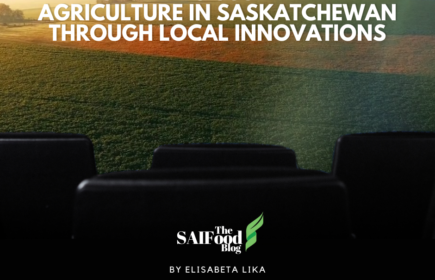By Elisabeta Lika
The Global Institute for Food Security (GIFS) at the University of Saskatchewan recently conducted an in-depth study on the carbon footprint of key crops grown in Saskatchewan. Detailed at GIFS Sustainable Agriculture, the study highlights the significant strides Saskatchewan’s agricultural sector has made in reducing greenhouse gas (GHG) emissions through innovative farming practices. By focusing on crops like canola, wheat (durum and non-durum), field peas, and lentils, it reveals how local techniques are setting new benchmarks for sustainability in agriculture.
To understand the impact of these practices, a 2022 Carbon Life Cycle Analysis led by GIFS investigates the GHG emissions associated with producing these crops. They compared Saskatchewan’s emissions against global averages, showcasing the distinct advantages of Saskatchewan’s farming methods. They examined each phase of production, from seed to harvest, including the use of fertilizers and the impact of transportation, providing a comprehensive picture of the environmental footprint of these crops.
Across all crops studied, Saskatchewan’s agricultural practices significantly outperformed those of other major global producers in terms of lower carbon emissions, setting new standards for global agricultural practices.
Sask Crops
Saskatchewan’s production of canola features the lowest carbon footprint among the crops studied, with emissions 67% lower than the global average. This is attributed to the widespread adoption of no-till farming and minimal use of fertilizers, which enhance the soil’s natural ability to capture and store carbon. The carbon footprint of producing one tonne of canola in Saskatchewan is 372 kg of CO2 equivalent, compared to the global average of 1,132 kg of CO2 equivalent.
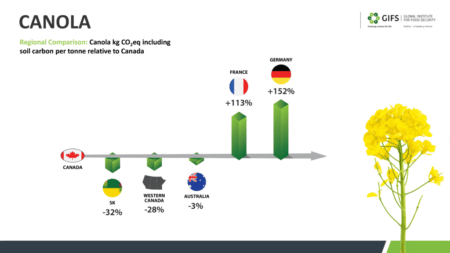
Similarly, the carbon footprint for non-durum wheat in Saskatchewan is reported 62% lower than the global average in 2022. Advanced agronomic practices in place such as reduced field activities and strategic crop rotations, contribute to this substantial decrease in GHG emissions. Saskatchewan’s carbon footprint for non-durum wheat is 214 kg of CO2 equivalent per tonne, whereas the global average is 561 kg of CO2 equivalent.
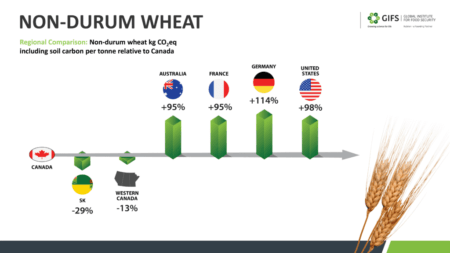
Durum wheat in Saskatchewan has a remarkably low carbon footprint, 78% lower than the global weighted average. This low footprint is due to effective soil carbon sequestration, a result of sustainable farming practices prevalent throughout the region. The province’s carbon footprint for durum wheat is 155 kg of CO2 equivalent per tonne, significantly lower than the global average of 699 kg of CO2 equivalent.
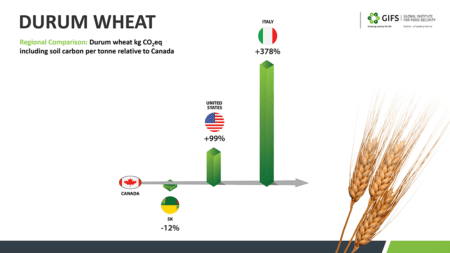
The production of field peas in Saskatchewan showcases an outstanding reduction in carbon emissions, being 96% lower than the global average. The crop’s ability to fix nitrogen reduces the need for nitrogen-based fertilizers, significantly lowering the overall environmental impact. For field peas, the carbon footprint is 40 kg of CO2 equivalent per tonne in Saskatchewan, compared to the global average of 965 kg of CO2 equivalent.
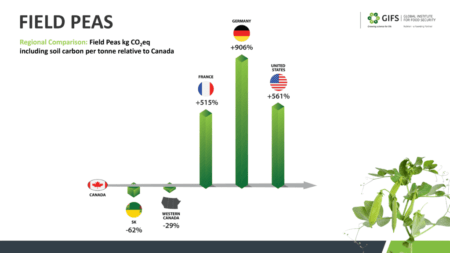
Perhaps the most interesting and impressive result is seen in lentil production, which not only has a lower carbon footprint compared to other regions but actually achieves a negative carbon intensity. This means that the cultivation of lentils in Saskatchewan results in a net removal of carbon dioxide from the atmosphere due to high levels of soil carbon sequestration exceeding the emissions associated with growing the crop. Saskatchewan achieves a carbon footprint of -177 kg of CO2 equivalent per tonne, while the global average is 596 kg of CO2 equivalent.
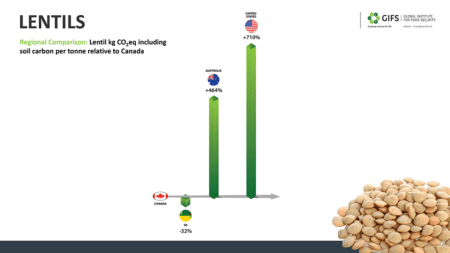
Impacts not just numbers
The findings from this study are not just numbers on a page; they are a call to action for both policymakers and farmers worldwide. They demonstrate that sustainable practices can coexist with productive agriculture and suggest that adopting similar strategies globally could significantly reduce the agriculture sector’s impact on the planet. All stakeholders—from farmers and agricultural companies to policymakers and environmental advocates—are encouraged to explore the full study and consider how these insights could be applied globally. The detailed findings, available at GIFS’ Sustainable Agriculture page, offer a blueprint for reducing carbon footprints in agriculture around the world.
Overall, the study conducted by GIFS demonstrates conclusively that the agricultural practices adopted in Saskatchewan lead to significantly reduced GHG emissions for several key crops. The approach used, which includes no-till and minimal-till farming, the strategic use of fertilizers, and the cultivation of nitrogen-fixing crops, serves not only to decrease carbon footprints but also to enhance soil health and agricultural sustainability.
These findings provide a clear, evidence-based indication that adopting similar sustainable agricultural practices on a wider scale could help other regions and countries to significantly reduce their agricultural carbon emissions. The adoption of these methods could be a critical step in addressing the global challenge of climate change, offering a path toward more sustainable agricultural production worldwide. For more detailed insights and the complete study, visit GIFS’ Sustainable Agriculture page.
Elisabeta Lika, M.Sc.
 Elisabeta is an economic analyst with experience in agriculture and food policy, environmental and resource economics, and national security matters. Previously, she worked at the State Intelligence Service, the primary governmental intelligence agency of Albania. She holds a bachelor’s degree in business administration and economics from American University in Bulgaria and a Master’s of Science in agricultural economics from the University of Saskatchewan. At the U of S, her thesis focused on the economic value of the Saskatchewan River Delta ecosystem and was supervised by Dr. Patrick Llyod-Smith.
Elisabeta is an economic analyst with experience in agriculture and food policy, environmental and resource economics, and national security matters. Previously, she worked at the State Intelligence Service, the primary governmental intelligence agency of Albania. She holds a bachelor’s degree in business administration and economics from American University in Bulgaria and a Master’s of Science in agricultural economics from the University of Saskatchewan. At the U of S, her thesis focused on the economic value of the Saskatchewan River Delta ecosystem and was supervised by Dr. Patrick Llyod-Smith.
Currently, Elisabeta is ending her two-year term position with us this July. During her time with us, she has done amazing work! We have been lucky enough to have her work on analyzing data from the Crop Rotation Survey and contributing to published articles.
Connect with her on LinkedIn to explore her areas of expertise further or discuss shared interests.


